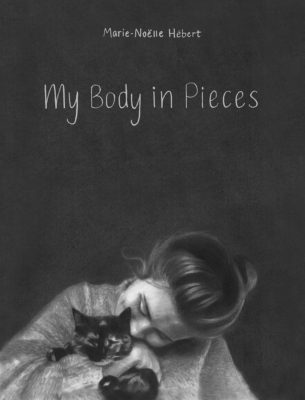My Body in Pieces is Marie-Noëlle Hébert’s first graphic memoir, which recounts her personal journey coming to terms with her own body. Spanning from her childhood to her twenties, this moving autobiography goes well beyond ill-fitting clothes and fat-shaming. It delves into how bullying and unsolicited comments only further fuel the deep sentiments of self-loathing that no amount of exercise or dieting can overcome. Of particular note is the fact that these profound feelings are conveyed mainly through the author’s accomplished drawings rather than the story’s text.
Marie-Noëlle’s story opens when she is in her twenties, living in her own apartment. She feels a heavy weight on her chest, anxiety which is beyond remedy. She calls her mother to ease the pain, but her mother only asks her if she has had enough water to drink. No one seems to be able to help Marie-Noëlle assuage her pain. After being “friendzoned” by a love interest, she holes up in her apartment, refusing to see friends to hide her rejection.

My Body in Pieces
Marie-Noëlle Hébert
Translated by Shelley Tanaka
Groundwood Books
$19.95
paper
106pp
9781773064840
Along the way, she receives a lot of advice on how to negotiate her presence in the world. She is advised to wear dark colours, never horizontal stripes or tight clothes. And of course, she is repeatedly told to pull in her stomach. The message that Marie-Noëlle internalizes at a very young age is that what people see, her body, is what counts and not her, the person.
Life intensifies in high school, where appearances are everything. Her parents sign her up for soccer. She trains hard and loses weight, for which she is commended. But the unsustainable, gruelling exercise and regimented eating mean that Marie-Noëlle puts even more pressure on herself to maintain her weight, which ultimately leads to further guilt, anxiety, and self-loathing.
If that weren’t enough for a teenage woman to handle, there’s the bullying at school and her father’s vicious remarks at home. All of this casts further doubt in her mind that she is lovable. Fortunately, she has many friends. In fact, it is her friend Matilda in whom Marie-Noëlle is finally able to confide about her negative feelings about her body. Matilda tells Marie-Noëlle to seek help, which she does after teetering on the brink of suicide.
With a graphite pencil to tell her story, Hébert uses realistic drawings that evoke the lightness and darkness of her thoughts. Her panels resemble black and white photographs, which work perfectly with the flashbacks she uses throughout her story. Many panels are intentionally blurred, reflecting a vague memory or a feeling of discomfort. The book itself is well crafted, with Hébert skillfully drawing the reader’s attention to important details.
Marie-Noëlle’s story gives the reader keen insight into what it is like to live in a body that does not conform to society’s unrelenting beauty standards. It also shows that even people with good intentions, such as Marie-Noëlle’s aunt who gives her a book on dieting, can ultimately undermine how someone feels about themselves. But more than anything, My Body in Pieces offers a glance at what lies below the surface of someone struggling with their body image. There is nothing sugar-coated in this story. It is heartbreakingly honest, and it is a book that every teacher, guidance counsellor, and psychologist should have in their library. mRb






0 Comments